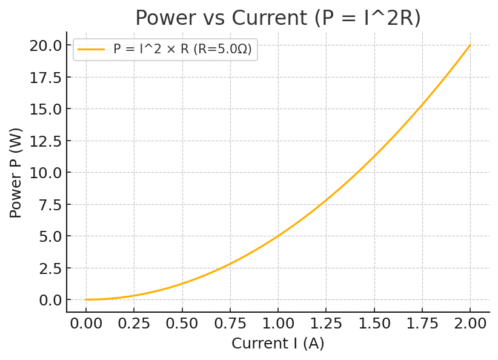Electrical power and efficiency are two key parameters that determine how effectively a circuit converts and uses energy. In real circuits, not all supplied energy reaches the load — part of it is inevitably lost as heat or electromagnetic interference (EMI).
Symbol: P Unit: Watt (W)
Power represents the rate at which electrical energy is consumed or converted. The basic formula is:
P = V × IOther useful forms (when resistance is known):
P = I² × R
P = V² / R
Example 1: A 10Ω resistor carries 2A of current. Calculate its power dissipation.
P = I² × R = 2² × 10 = 40 WExample 2: A 12V–6W lamp. Find the current:
I = P / V = 6 / 12 = 0.5 ASymbol: η (eta) Unit: %
Efficiency measures the ratio of useful output power to total input power:
η = (P_out / P_in) × 100%Example: A linear regulator with 12V input, 1A load, and 5V output:
P_in = 12 × 1 = 12W
P_out = 5 × 1 = 5W
η = (5 / 12) × 100% ≈ 41.7%Over 7W are lost as heat — which is why linear regulators need large heatsinks.
| Criteria | Linear Supply | Switching Supply (SMPS) |
|---|---|---|
| Efficiency | 40–60% | 80–95% |
| Size | Bulky | Compact, lightweight |
| Noise | Low | High (EMI) |
| Applications | Audio, measurement devices | Computers, chargers, industrial systems |
Exercise 1: A 24V source powers a 120Ω resistor. Calculate the current and power.
I = 24 / 120 = 0.2A
P = 24 × 0.2 = 4.8WExercise 2: A power supply input: 9V–2A; output: 5V–3A. Find its efficiency.
P_in = 9 × 2 = 18W
P_out = 5 × 3 = 15W
η = (15 / 18) × 100% = 83.3%Understanding power and efficiency allows engineers to design safe, reliable, and energy-efficient circuits. Applying P = V×I and η = P_out/P_in helps optimize power consumption, reduce thermal losses, and improve circuit longevity.
Keywords: electrical power, efficiency, P=VI, power dissipation, SMPS, linear supply, circuit design, basic electronics